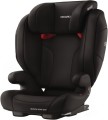ADAC test result
The results shown by the seat in crash tests according to the standards of ADAC — the General German Automobile Club, an authoritative European organization of motorists.
Car seats in such tests are evaluated in several categories, but in this point only one parameter is taken into account — the safety of the child, his/her protection in emergency situations. The results of such a test are indicated by the number of points; the fewer points in the end — the safer the product. It should be noted that the ADAC standards are much stricter than those by which the seat is evaluated during mandatory certification; tests are conducted with different directions of impacts (frontal and side), with dummies of different ages and so on. Therefore, the result of the ADAC test very reliably describes the real level of protection that the product provides in accidents.
According to this indicator, modern car seats can be divided into the following categories:
—
very good (< 1.5);
—
good (1.6 – 2.5);
—
satisfactory (2.6 – 3.5);
—
acceptable (3.6 – 4.5);
— unacceptable (more than 4.5).
The downside of a good value is usually a higher price; however, in an accident, that price may be a very small price to pay for the extra protection that can save your baby's life and health.
In c
...onclusion, it should be noted that ADAC test methods are constantly being improved and tests are conducted every year. Therefore, when choosing a seat and comparing it with its counterparts, you should also pay attention to the year of manufacture; as a rule, newer products with the same number of points give a higher actual level of protection than older ones.Recommended height
Recommended values of the minimum and maximum height of the child (in centimeters), at which the car seat provides optimal safety and comfort. The parameter must be taken into account when choosing a child car seat along with the age and weight groups, because children of the same age can have different heights and weights.
Adjustments
—
Backrest tilt adjustment. The backrest tilt can be adjusted. This point is different for various weight groups. In groups 0+ and 1 not the backrest, but the whole seat tilts against the fixed base, and in groups 2 and 2/3 only the backrest tilts. The possibility of adjusting the backrest tilt is important if the child is in the car for a long time – by tilting the backrest you can let the child sleep or rest.
—
Headrest height adjustment. According to safety requirements, the child's head should not be more than one third above the headrest, so it is necessary to adjust the headrest as the child grows.
—
Harness height adjustment. The ability to adjust the height of car seat harnesses — such a need arises as the child grows.
—
Backrest width adjustment. The ability to adjust the width of the backrest allows you to optimally adjust the car seat not only for constantly changing height, but also for the child's complexion.
—
Horizontal position of a backrest. The backrest of the car seat is horizontal. The horizontal position is optimal for babies under the age of six months, since it avoids unnecessary stress on the spine, therefore group 0 car seats usually have this function.
—
Removable backrest. It is possible to comp
...letely remove the backrest of the car seat. This function expands the possibilities of the seat: it can be used both for its intended purpose, with a backrest, and as a booster (for more information on boosters, refer to "Weight group 3").
— Swivel system. The seat swivels relative to a fixed base. This makes it easier to drop off and pick up the child: during these operations, the seat can be turned to face the car door, and when driving, it can be positioned in or against the direction of travel.
